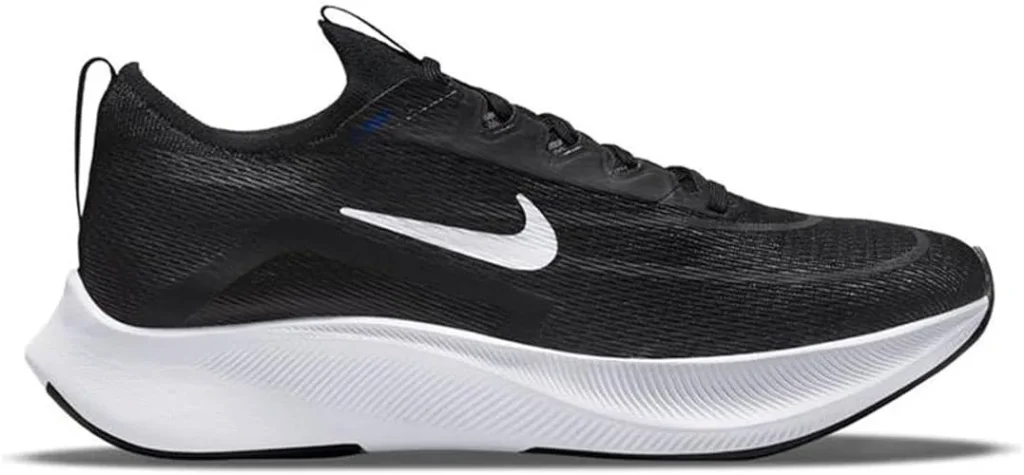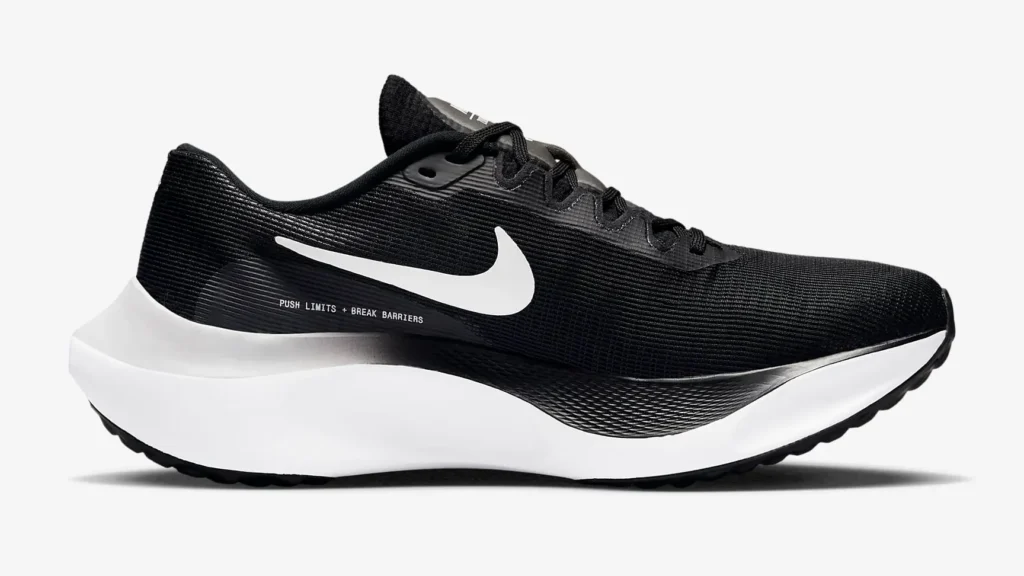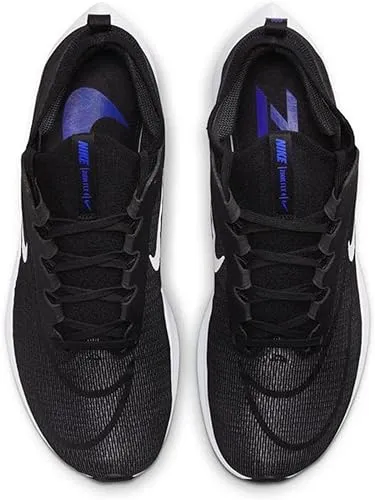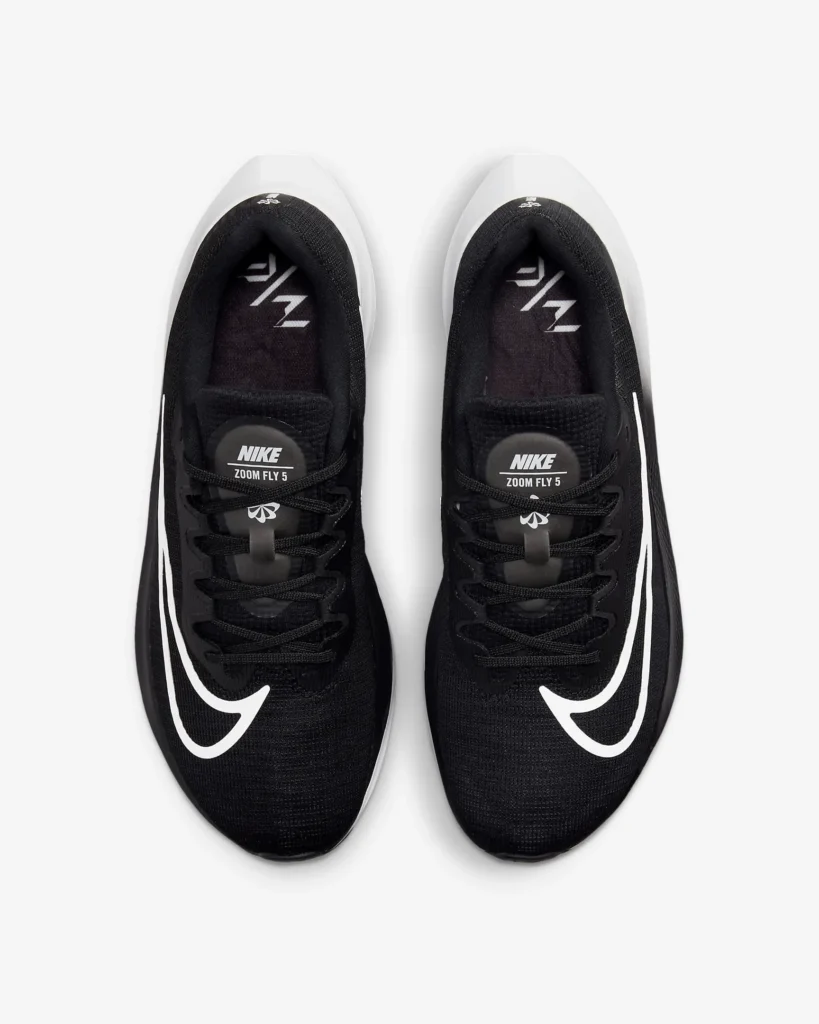Hey there, running enthusiasts! It’s time to take a close look at two of Nike’s latest and greatest running shoes – the Zoom Fly 4 and the Zoom Fly 5. These sleek kicks promise to take your stride to new heights, offering the perfect blend of cushioning, responsiveness, and durability.
Whether you’re a seasoned marathoner or a weekend warrior, this comprehensive comparison will guide you through the nitty-gritty details of each model, helping you make an informed decision that fits your unique needs and preferences like a glove.
Comparison Table between Nike Zoom Fly 4 And Zoom Fly 5:
| Feature | Nike Zoom Fly 4 | Nike Zoom Fly 5 |
|---|---|---|
| Launched In | 2021 | 2022 |
| Stability | Average lateral heel stability at slower speeds | Wider forefoot and heel base for improved stability |
| Flexibility | flexible | flexible |
| Sizing | Runs a bit narrow | Fits true to size |
| Weight | 9.6 oz (half pair, US size 10) | 314g (Men’s size 10) |
| Cushioning | React foam midsole | ZoomX foam midsole for more bounce |
| Outsole | Harder rubber (heel), softer blown rubber (forefoot) | Waffle-inspired rubber outsole |
| Midsole | Single-density React foam with Carbon plate | ZoomX foam with Carbon fiber plate |
| Upper | Fully-sleeved upper with stretchy tongue and midfoot strapping system | Lightweight mesh for breathability and foot conformance |
| Retail Price | $106 to $173 | $170 |
Features Comparison:
1) Materials: Outsole, Insole, Upper
The Nike Zoom Fly 4 features a durable outsole with harder rubber under the heel for better traction and softer blown rubber under the forefoot for a smooth toe-off. Its insole is ZoomX foam midsole and the upper boasts a fully-sleeved design with a stretchy tongue and midfoot strapping system for a secure, locked-in fit.


On the other hand, the Nike Zoom Fly 5 opts for a lightweight mesh upper that enhances breathability and conforms to the foot’s natural shape. The outsole features a waffle-inspired rubber design for reliable traction, while the insole is likely designed to complement the responsive ZoomX foam midsole, delivering a plush, bouncy ride.
2) Durability:
Both shoes incorporate high-quality materials and construction techniques to ensure long-lasting performance. The Zoom Fly 4’s React foam midsole and carbon plate are designed for better durability than PEBA foam-based shoes, while the Zoom Fly 5’s ZoomX foam and carbon fiber plate offer a resilient foundation that can withstand the rigors of regular training.
However, it’s worth noting that the React foam in the Zoom Fly 4 may be more susceptible to temperature fluctuations, potentially affecting its longevity in extreme conditions.
3) Fit:
The Nike Zoom Fly 4 is reported to run a bit narrow, which could be a concern for runners with wider feet. Its fully-sleeved upper and midfoot strapping system provide a secure, locked-in feel, but those seeking a roomier toe box might find it too constricting.


In contrast, the Nike Zoom Fly 5 is designed to fit true to size, accommodating a wider range of foot shapes and sizes. Its lightweight mesh upper conforms to the foot’s natural contours, ensuring a comfortable and personalized fit.
4) Cushioning:
The Nike Zoom Fly 4 features a React foam midsole with a carbon plate, delivering a responsive and cushioned ride suitable for high-mileage training. However, the React foam’s temperature sensitivity might affect its cushioning performance in extreme conditions.
The Nike Zoom Fly 5 takes cushioning to new heights with its ZoomX foam midsole, which promises a lighter, more responsive, and bouncier cushioning experience. The combination of ZoomX foam and a carbon fiber plate aims to provide a propulsive sensation, making each stride feel effortless and energized.
5) Stability:
While the Nike Zoom Fly 4 offers a stable platform, it may struggle with lateral heel stability at slower speeds, potentially compromising support during recovery runs or walk breaks.
In contrast, the Nike Zoom Fly 5 addresses stability concerns with a wider forefoot and heel base, providing a more reliable and confident foundation for tackling turns and longer distances.
6) Value for Money:
When it comes to value, the Nike Zoom Fly 4 offers a more budget-friendly option, with prices ranging from $106 to $173, depending on the retailer. This makes it an attractive choice for runners seeking a versatile, high-mileage trainer with ample cushioning and responsiveness without breaking the bank.
On the other hand, the Nike Zoom Fly 5 commands a premium price tag of $170, reflecting its advanced cushioning technologies, carbon fiber plate, and enhanced stability features. While more expensive, it may be a worthwhile investment for runners prioritizing top-of-the-line performance and cutting-edge innovations.
Performance Comparision:
1) For Walking:
The Nike Zoom Fly 4 and Zoom Fly 5 are primarily designed for running, but they can also accommodate walking activities. The Zoom Fly 4’s React foam midsole and carbon plate provide a responsive and cushioned feel, making it a suitable option for extended walks or recovery days.
However, the Zoom Fly 5’s ZoomX foam midsole and carbon fiber plate offer a more energized and propulsive sensation, potentially making it a better choice for those who prefer a more dynamic walking experience. Additionally, the wider base in the forefoot and heel of the Zoom Fly 5 may contribute to improved stability during walking.
2) For Running:
Both shoes excel in their respective running performances. The Nike Zoom Fly 4 delivers a comfortable and responsive ride, thanks to its React foam midsole and carbon plate integration. It’s an excellent choice for everyday training runs and long-distance efforts.
The Nike Zoom Fly 5, with its cutting-edge ZoomX foam and carbon fiber plate, aims to take running performance to new heights. The added bounce and propulsive sensation, combined with the waffle-inspired rubber outsole for reliable traction, make it an ideal companion for runners seeking a faster, more energetic stride, whether during speed work or race days.
3) For Standing All Day:
While neither shoe is explicitly designed for prolonged standing, the Nike Zoom Fly 5 may have a slight advantage due to its ZoomX foam midsole and wider base. The responsive cushioning and enhanced stability could provide some relief for those who need to spend extended periods on their feet.
However, for optimal comfort during long periods of standing, dedicated shoes or insoles specifically engineered for this purpose may be more suitable alternatives.
4) For Plantar Fasciitis:
Neither the Nike Zoom Fly 4 nor the Zoom Fly 5 is specifically tailored for individuals with plantar fasciitis. However, the cushioning and support features in both shoes could potentially alleviate some of the discomfort associated with this condition.
The Zoom Fly 4’s React foam midsole and carbon plate may offer adequate cushioning and responsiveness, while the Zoom Fly 5’s ZoomX foam and carbon fiber plate could provide additional shock absorption and propulsive support.
Ultimately, individuals with plantar fasciitis should consult with a healthcare professional or a specialized footwear retailer to determine the most appropriate shoe choice for their specific needs.
Conclusion: Which Is Better for You?
Choosing between the Nike Zoom Fly 4 and Zoom Fly 5 ultimately boils down to your unique needs, goals, and budget. The Zoom Fly 4 is an excellent choice for those seeking a versatile, high-mileage trainer with a responsive and cushioned ride at a more affordable price point.
The Zoom Fly 5, on the other hand, caters to runners who prioritize cutting-edge cushioning, propulsive technologies, and a premium running experience, justifying its higher price tag. Whichever you choose, you can trust Nike’s commitment to innovation and performance to elevate your running game to new heights.

